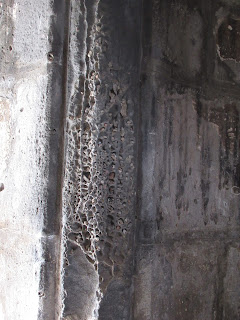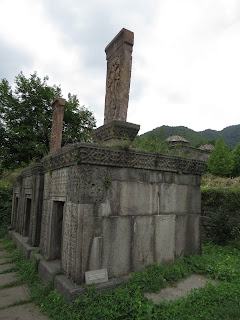When we met Shushan,
our guide for today’s tour from Yerevan’s Envoy Hostel to northern Armenia and on to Tbilisi, the capital of Georgia, we almost felt right at
home. She mentioned she had spent a school year in Fort Collins, Colorado,
as part of the US State Department’s FLEX program that pays for about 30-40
‘future leaders’ from each country in the former Soviet Union, after the
collapse of the USSR, to spend a high school year in the US. Nelli,
our great tour guide on the previous Envoy Hostel tour had also been the beneficiary of the
same program when she was based in Des Moines, Iowa. All the participants’
transportation costs are paid for as well as a small monthly stipend, Shushan
told us.
One of the most fascinating encounters we’ve had in a long
time with a fellow traveler was our talk with Rebecca, also on the day’s tour with us, who was originally from
Manchester, England, but had been working in Irbil, Iraq, for a humanitarian organization for almost 18 months,
after also working in Afghanistan for a few months. She said she was moving
soon to work for MAG, the Mines Advisory
Group, in Cambodia, as she felt she had developed a false sense of security
living for so long in Irbil, a city she declared was pretty safe! She mentioned she's spent so many years working abroad she was no longer eligible for health and other benefits when she returns to see family in England.
We stopped at a huge bakery in Aparan for a sugar high as Shushan said
we had a long drive ahead of us before we would stop again. Nobody complained
when we saw the treats there!
Unfortunately, a blurry picture of lavash, the Armenian bread:
More than three hours later, we stopped at the beautiful Debed Canyon to take some photos. Four subjects were taught in the small hallway known as the Academy: astronomy, theology, math and philosophy.
In the adjacent gavit or narthex of the church, one pillar represented each of the four subjects. It was spooky for us walking over the gravestones, even though we knew that was the acceptable practice in Armenia as doing so erases the departed person's sins.
There was an image of the Virgin Mary, however, in an alcove.
The second church of the monastery was accessed through the gavit. There, a library was kept but hidden under the rocks in the center and therefore away from potential marauders.
Shushan mentioned two pagan traditions had been adopted into the church. One was the celebration of the goddess of water in early July where everyone faces the chance of being sprayed with water or having water dumped on them that day! The second was when something good arises out of a bad situation, everyone is invited to share in the good fortune. She mentioned the examples of two former drug addicts who had a baby and a friend’s mother who was recovering from cancer. In each case, all the neighbors and family members were invited to participate in the feast hosted by the happy families.
The official Library was closed as it often was for some reason, Shushan stated.
As we walked to St. Gregory's Chapel, Shushan mentioned that our wishes will come true if we place a stone in one of the crevice in the pillar's chapel and it stays put. That was a slam dunk compared to trying to toss a stone in the crevice high above the ground in another monastery we visited a few days earlier!The chapel was only big enough for a few people.
The last shot of Sanahin Monastery:
Souvenir sellers near the monastery complex had a beautiful array of Armenian products but we were concerned with space. Maureen: As you know I had brought so many granola bars and small bags of raisins and almonds with me to snack on I needed to eat a lot more of them to make way for souvenirs!
The tour included a nice lunch again - this time, the main menu item was Armenian BBQ - with a local family. This was the only time we ate outside, which we enjoyed since we'd spent so much time cooped up in the van in the almost ten-hour journey north to Tbilisi.
Back on the bus, in the distance we could see smoke rising. Shushan mentioned tit came from a copper mine which was only now working at half capacity compared to what it was like during the Soviet period. That was a good news/bad news situation: the good news meant it was much better for the environment but the bad news was it was bad for the local economy.
We didn’t reach Haghbat Monastery til about 3 pm. It functioned as a monastery until the 19th century and reopened as a church after the collapse of the Soviet Union.
Shushan mentioned it was encouraged to stand on the gravestones outside the front of the church as their purpose after death is to lead people to God, something previous guides hadn't told us.The gavit was covered with yet more gravestones.
There are two services held every Sunday at 11. High above the altar and another area of the church, restorers were working painstakingly to bring back the frescoes that had been whitewashed by the Soviets in preparation for a visit by Tsar Nicholas. This was the only church we'd seen in Armenia that had any frescoes as they normally believe the simpler the church, the closer to God worshippers are.
Also very unusual were the pews in the church as Armenian believe people attending services shouldn't be comfortable to feel close to God. However, the people coming to this church are getting older and therefore need to sit during the up to two hour-long service.
A view from the church of Steven exiting the gavit: Again, unlike other monasteries we had visited in Armenia, here at Haghbat, all the buildings were separated and not one joined complex where we had gone from gavit to church to another chapel, etc.
On the grounds were these khachkars or tombstones that we had seen so many of especially near Lake Sevan in eastern Armenia. Shusan stated there are more than 100 meanings to what is a khachkar and each has its own pattern. It was the honor of the stonemason to create something that had never been created before.
The monastery's dining hall was included in scenes in the Armenian film director, Sergei Paradjanov's film called The Color of Pomengranate. We had already toured his former home in Yerevan so were happy to see his work here at the monastery. After he made the elaborately carved front door to the dining room for the movie, the locals liked it so much they kept it!
The image was of two sons holding a stone given to them by their mother. One son built Haghbat; the other built Sanahin across the valley we had seen a bit ago.
As we explored more of Haghbat Monastery, Shushan talked about the discord - really, a case more of political turmoil between the two nations - between Armenia and the neighboring country of Azerbaijan. Religion plays such a big role in Armenian culture that made it easier to resist Muslim influence in Armenia. I am getting ahead of myself here but there is such friction between the two countries over a disputed territory that each country's citizens cannot visit the other nation. Furthermore, in order for us to visit Azerbaijan, we had to devise our entire itinerary around starting in Armenia and then going to Georgia before going onto Azerbaijan from there.
The UNESCO-listed Haghbat Monastery had been a very interesting and appealing stop because it was so beautiful in its own right, was in a stunning setting and also as it was so different from any of the other Armenian monasteries we had already seen.
Our last stop before the border crossing to Georgia was another UNESCO-listed site, Akhtala Church, which used to be a monastery. As it was so close to the Georgian border, it was a mixture of both countries' styles.
Once through the gate, we saw these large rings well before reaching the church. Shushan commented they symbolized the friendship between the two countries. Atop the rings was a pomegranate, an image we'd seen on almost every souvenir throughout Armenia!
On the base before the first and second rings were a scorpion and a snake. It was important to step on both as we walked between the rings for good luck!
There were Greek inscriptions above the altar because, when Armenians went to the Byzantine Empire to learn to paint, Greek was the language used at the school and they were told to incorporate the Greek language when they returned to paint the frescoes in Armenia.
The colors on the 13th century frescoes above the altar were amazingly vivid because 'they never see the light,' as Shushan stated, i.e. they weren't affected by the sunlight.
Next post: A huge foul up with our accommodation in Tbilisi but all's well that ends well!
Posted on August 30th, 2018, from Kutaisi, in western Georgia.
If no comment window appears, click on the words "No
comments", "1 comment" or " 2 comments", etc. that
appear below and a new window will appear for you to leave a comment. CLICKING
ON THE POST TITLE BEFORE READING WILL ALSO OPEN THE COMMENT WINDOW.






















































Loved the photo of you 2 at Debed Canyon. Lil Red
ReplyDeleteThe pictures of Akhtala Church were spectacular!! I love the old feel and views of them as they remind me heavily of medieval Europe and the knights era
ReplyDeleteHon,
ReplyDeleteSo glad you liked the photos so much of the church as I thought the place was pretty spectacular and wanted to convey that through the pictures. Can certainly see the emotional connection between the churches of Georgia and those in medieval Europe.
Missing you from Khiva, Uzbekistan!
Makes Canada feel like it's brand new.
ReplyDeletePretty churchy region of the world.
Paul, Traveling through much of Georgia did make us realize how indeed 'new' the New World is compared to what we were lucky enough to explore. We certainly had our fill of monasteries for a while after seeing so many in Armenia and Georgia but we're back in the land of cathedrals and basilicas here in Spain now! Wonder how long it'll be before we're 'churched' out - guess we'll need to pace ourselves as we're only in Bilbao in northern Spain now and have far more religious institutions to see in the next month or so!
DeleteXOXO